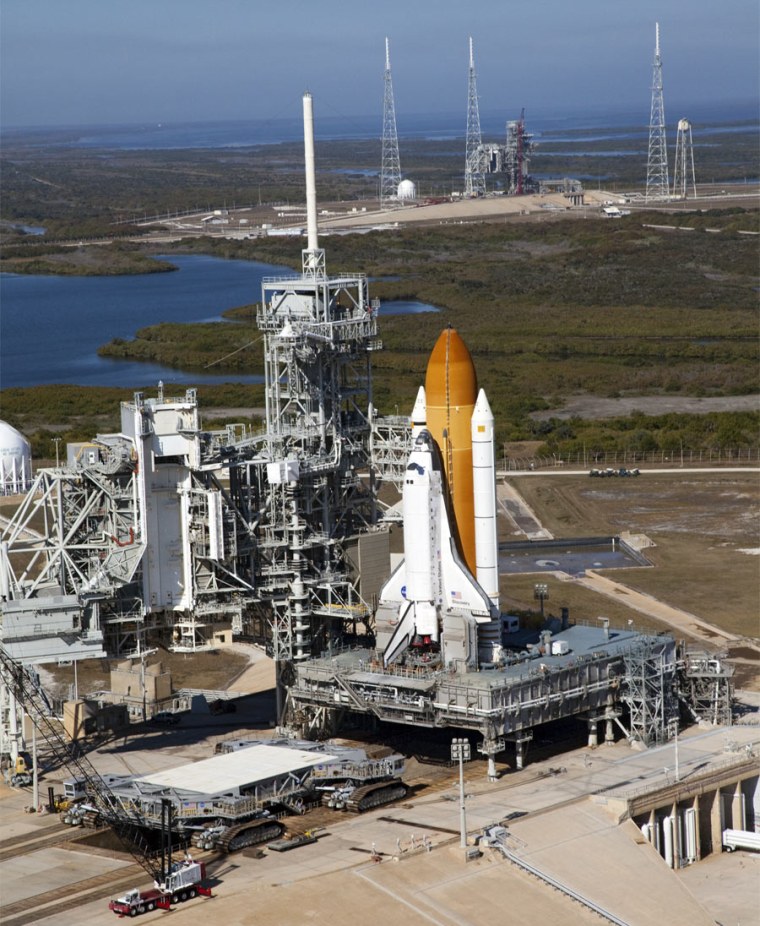NASA's space shuttle Discovery may be hanging up its wings after one last mission, but it will leave a long legacy of performance in orbit that will be a challenge for any future spacecraft to match.
Discovery is NASA's oldest flying space shuttle and the most traveled winged spaceship in the fleet. It has flown more missions, and carried more astronaut crewmembers, than any of NASA's other shuttles, agency officials have said.
The shuttle is flying its final mission – STS-133 – before being retired along with the rest of NASA's orbiters later this year. The 11-day mission launches Thursday and will deliver a new storage room and humanoid robot to the International Space Station. [Gallery: Building Space Shuttle Discovery]
"Discovery has been a really remarkable vehicle for us and the program," NASA test director Jeff Spaulding told reporters this week. "She still has a few more miles to go before she sleeps, though."
Here's a by-the-numbers look at Discovery's lasting legacy in space that, according to NASA, will cement the shuttle's place in the fleet's record books:
143 million: The number of miles Discovery has traveled so far, with one flight remaining. This is a distance record unmatched among NASA's space shuttle fleet. The miles traveled by Discovery could have carried it to the moon and back 288 times, or on 1.5 trips to the sun.
40,000: The number of spectators NASA reportedly anticipated to have watching Discovery's final launch from the Kennedy Space Center in Cape Canaveral, Fla.
17,400: The speed at which Discovery travels (in miles per hour) to remain in orbit. It's about Mach 25, or five times the speed of a bullet.
5,628: The number of orbits Discovery has flown around Earth. During spaceflight, Discovery completes one orbit around Earth every 90 minutes.
1984: The year Discovery blasted off on its maiden space voyage. Discovery's first flight was NASA's STS-41D mission, which launched on Aug. 30 carrying three communications satellites and an experimental solar array wing. The mission was commanded by astronaut Henry Hartsfield.
363: The number of cumulative days Discovery will have flown in space by the end of its career. Altogether, that's just over 51 weeks. Put another way, if you were to string all of Discovery's mission's together into one mission, the shuttle would be in space for almost an entire year.
246: The number of crew members Discovery has carried during its space career so far. According to NASA, Discovery has been the ultimate space taxi and carried the most astronauts of any shuttle.
39: The number of missions Discovery will have flown by the time it is retired.
13: The number of times Discovery will have docked with the International Space Station after it is retired.
5: The number of astronauts that marked a first-ever in space when they flew on Discovery. According to NASA, they include: the first female to ever pilot a spacecraft (former astronaut Eileen Collins); the oldest person to fly in space (former astronaut John Glenn); the first African-American to perform a spacewalk (former astronaut Bernard Harris); the first cosmonaut to fly on an American spacecraft (Russian spaceflier Sergei Krikalev); and the first sitting member of Congress to fly in space (then-Sen. Jake Garn, R-Utah).
4: The number of years it took to build the space shuttle Discovery. The shuttle was completed in October 1983 in Palmdale, Calif., and was shipped a month later to NASA piggyback atop the agency's modified Boeing 747 shuttle carrier craft. Four is also the maximum number of times the shuttle has flown in space in a single year. In 1985, Discovery set the bar for number of flights by one orbiter in one year.
3: The number of satellites Discovery carried during its first launch. Discovery was also NASA's third space shuttle built for orbital flight. It was built after the shuttles Columbia and Challenger.
2: The number of return-to-flight missions Discovery has flown to help NASA resume shuttle flights. Discovery was the shuttle that flew the STS-26 mission two years after the loss of shuttle Challenger and its crew during launch on Jan. 28, 1986. The shuttle also flew the STS-114 mission that followed the 2003 loss of shuttle Columbia and its seven-astronaut crew. That mission launched in July 2005.
1: The number of actual dockings with Russia's Mir space station Mir. Discovery visited the Mir station twice. It was the first U.S. shuttle to rendezvous with (but not dock at) Mir in 1995. Its second and last trip to Mir was in 1998, when it actually linked up with the Russian space station.
You can follow Space.com managing editor Tariq Malik on Twitter. Staff writer Denise Chow ( @denisechow ) is providing mission coverage of Discovery's final space voyage from Cape Canaveral, Fla.
